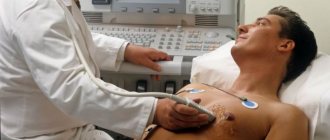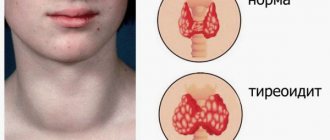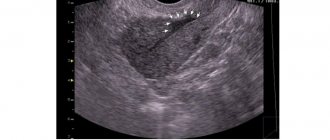0
Author of the article: Marina Dmitrievna
2017.07.13
16 097
Symptoms
Aching pain in the heart occurs in everyone, but is not always accompanied by a change in blood pressure. Lately, more and more often patients are complaining about just such symptoms. What is this connected with? Why does my heart hurt, but my blood pressure is normal?
Chest pain
To understand this issue, it is necessary to understand the root cause of the symptoms. A cardiologist will help you place all the emphasis. In some cases, consultations with an endocrinologist and neurologist will be required. Examinations of the cardiovascular system and thyroid gland will help to understand the cause of pain in the heart area.
Causes of pain
Differences in blood pressure affect the entire body, so the symptoms of heart pain may vary. With low blood pressure, pain in the cardiac region is paroxysmal. They appear in the morning. The pain does not extend to the left arm, shoulder or jaw.
Important! With high blood pressure, the pain is pressing and aching.
It is difficult to determine the duration of pain in the left side of the chest, since it appears and disappears throughout the day. Often appears after physical exertion or stress. If pain in the heart increasingly makes itself felt at night and during periods of calm, then consult a doctor immediately. With increased pressure, pain in the left side of the sternum is a signal of an attack of angina, myocardial infarction, coronary spasm, etc.
If the pressure is within normal limits, but the heart pain does not go away, then the cause of its occurrence may be:
- overwork;
- stress factor;
- state of depression;
- vegetative-vascular dystonia;
- sudden change in weather conditions or climate;
- prolonged insomnia;
- lack of vitamins in the diet;
- bad habits.
This list lists the main reasons for the manifestation of the condition when the pressure is normal, but the heart hurts. A cardiologist can name the exact cause. If during the examination no serious organic or functional changes in the organ are detected, then minimal therapeutic treatment is prescribed. They recommend eating right, getting plenty of rest, and monitoring your vitamin intake.
Healthy lifestyle
When high blood pressure is detected in combination with heart pain, more serious treatment is prescribed, but it all depends on the diagnostic result.
Heart pain due to arterial hypertension
Heart pain is not a direct cause of high blood pressure. Although a hypertensive crisis may be accompanied by pain in the chest, they are observed in only one patient out of four.
But chronically high blood pressure leads to other heart diseases. They are the ones who cause pain. Most often, arterial hypertension is combined with coronary heart disease. High blood pressure is detected in 80% of patients with coronary artery disease.
In Russia, as in other European countries, there is insufficient control of arterial hypertension. Only half of patients receive adequate antihypertensive therapy. The rest receive only occasional treatment or no treatment at all. This leads to damage to target organs, one of which is the heart.
Pain characteristic of angina pectoris occurs. They intensify or appear during physical activity or stress, weaken or disappear in a state of physical and emotional rest.
What heart lesions cause pain?
If pain appears in the left region of the sternum, but blood pressure is normal or slightly decreased, the doctor may assume the presence of organic and functional changes in the heart.
Organic changes are easier to diagnose, as they manifest themselves as damage to the heart muscle or blood vessels in the area. Functional ones appear without organic changes. An electrocardiogram or echocardiogram will help determine the problem.
Organic pathologies develop for the following reasons:
- inflammation of the epicardium, myocardium and pericardium;
- ischemic disease;
- arrhythmia;
- congenital heart defects, etc.
All this develops due to improper blood circulation in different areas of the organ. Various inflammations or injuries prevent normal blood flow to the heart. The organ hurts due to lack of oxygen, insufficient nutrition of cells with vitamins and microelements.
Important! Do not forget about thyroid diseases, which often, due to insufficient production of hormones, cause the heart to beat faster or hurt without changing blood pressure.
A lack of adrenal hormones, anemia or an excess of thyroid hormones will affect the functioning of the heart. Due to these reasons, cardiac pain in the left region of the chest develops gradually, without drawing attention to itself. When organic lesions develop, attacks of heart pain increase in frequency and intensity.
"Bad" cholesterol will never become good cholesterol
— You often hear from doctors about risk factors that every person should know about. But what is it and what should you pay attention to first?
- The most important risk factors for cardiovascular mortality, which had already become known by the end of the 50s, are the following conditions and diseases: age and family history - factors that cannot be influenced. But there are other factors: smoking, arterial hypertension, cholesterol levels, diabetes, obesity, which can be influenced. By the forties of the twentieth century, it became clear that people most often die not from infections, as was the case before, but from cardiovascular diseases. Therefore, the American Heart Institute was organized, and since 1948, in Framingham, a small town near Boston, all residents of the city were included in a study that continues to this day. They measured blood pressure, sugar, fibrinogen and many other indicators. These data were subsequently confirmed in large randomized controlled trials. Special tables have been created that allow one to estimate the risk of death within 10 years depending on the presence of selected factors. By the way, controlling these risk factors lengthens life and improves its quality.
— And what level of cholesterol in the blood can be considered normal?
— Not so long ago, a cholesterol level of 6.5 mmol/liter was considered the norm in Russia, and 3.5 mmol/liter in Japan. Now in Europe, the USA and Russia, the normal level of total cholesterol is considered to be below 5.2 mmol/l. However, the main indicator is low-density lipoprotein cholesterol, popularly called “bad cholesterol”. In people with a low risk of developing coronary heart disease, it should be less than 3.0 mmol/l, in patients with a high risk - less than 2.6 mmol/l, and in those who have atherosclerosis and its complications - coronary heart disease, brain disease and other vascular zones, its target level is less than 1.8.
— I was prescribed statins, but I’m afraid to take them, supposedly they cause cataracts, strokes, diabetes, impotence, etc. Is this true?
— Cholesterol in elevated quantities actually causes a number of diseases, primarily vascular damage. Statins are drugs that lower cholesterol levels, thereby preventing these diseases. But in addition to this, statins also have a unique anti-inflammatory effect inside blood vessels. To date, there are no drugs in this area that are more effective than them, and with few side effects. As for cataracts, stroke, impotence, research results do not confirm these complications. An increased incidence of diabetes mellitus was shown in one recent analysis, but mainly in patients with a hereditary predisposition to the disease. In diabetes mellitus, the benefits of such drugs are especially high, since it is with this disease that atherosclerosis develops more often and earlier.
photo: Alexandra Zinovieva
But: statins are not prescribed in the presence of severe liver failure and liver diseases; for this purpose, biochemical markers are initially monitored.
— Are statins prescribed in old age? I am 64 years old. When walking, pain began to arise in the legs, which went away very quickly after stopping. I can walk about 300–400 meters at a slow pace. Is this related to smoking? And where should I go?
— Statins are especially effective in old age, when the processes of growth of atherosclerotic plaques are most active. For patients over 80 years of age, I try to prescribe not the highest doses, taking into account the condition of other organs. As for pain in the legs, then, most likely, you have developed obliterating atherosclerosis of the arteries of the legs, which is characteristic of smokers. That is, the arteries that bring oxygenated blood to the legs are partially blocked by atherosclerotic plaques. Smoking often leads to damage to the arteries in the legs. What should we do now? First of all, do not wait for complete closure of the vessels and gangrene, but quit smoking to stop the progression of the process. Then do an ultrasound duplex scan of the arteries of the legs, preferably the vessels of the neck - smoking is the enemy of all blood vessels. Your cardiologist will then prescribe therapy to stabilize the plaque and improve blood flow. It will also become clear whether and what kind of vascular surgery is necessary. In any case, the success of therapy and surgery depends on you - you must quit smoking.
“My dad suffered a stroke, and now doctors say that more than half of his carotid arteries are closed. We are afraid of surgery. How can we solve this problem?
— If during the last six months your father suffered a stroke and a vascular examination revealed stenosis in the carotid arteries of more than 70%, then he is indicated for revascularization surgery, that is, an operation to restore normal blood flow in the arteries of the brain. In addition, all patients with atherosclerotic changes in the carotid arteries should receive optimal drug therapy to reduce cholesterol, blood pressure, blood sugar, etc.
Can blood pressure cause pain in the cardiac region?
The answer to this question is clearly positive, because blood pressure affects the volume of cardiac output, blood circulation and the tone of the vascular walls. Cardiac output is the amount of blood that the heart throws out during one contraction.
Blood pressure measurement
When blood pressure decreases, the patient may experience:
- severe and severe weakness;
- fatigue;
- noise in ears;
- shortness of breath;
- headache;
- pain in the heart, similar to a sharp compression of the organ or squeezing in the left region of the sternum.
With increased pressure, the pain may radiate to the left side. There is a feeling that the pain covers the entire chest.
Pain behind the sternum and in the cardiac region is not characterized by spreading to the left arm, shoulder or scapula. Taking nitroglycerin for hypotonic pain does not improve the condition and can increase the intensity of pain in the heart and head. In this condition, there is no guarantee that a person will not become a victim of an attack of angina or myocardial infarction. It is especially worth paying attention to the nature of the pain. It can be stinging. In this condition, you must immediately call an ambulance and take a nitroglycerin tablet under the tongue.
What is pulse
Pulse is a certain frequency of oscillations of the vascular walls, occurring as pushes, which depends on the rhythm of the heart. At normal blood pressure in a healthy person, the heart beats from 60 to 85 times per minute, but this parameter can be subject to changes due to age, lifestyle and health status. Also, the heart rate (hereinafter referred to as heart rate) is influenced by the psychological state, level of physical activity and the environment.
A persistent increase in heart rate, not associated with physical activity and an increase in blood pressure, is called arrhythmia and indicates a malfunction of the heart. The same condition is also observed with elevated blood pressure values, but pathological changes are observed, as a rule, in more than one cardiac region. Tachycardia is a diagnosis made when the heart rate increases to 90 times per minute or higher.
What to do if an increased pulse with normal pressure is recorded more and more often? Contact a cardiologist to identify the causes of the syndrome and prescribe a therapeutic course, if necessary.
Treatment
Without organic and functional disorders, the heart can hurt for various reasons, but treatment remains complex. Cardiologists recommend:
- regulate your daily routine and sleep (sleep at least 8 hours);
- walk more often in the fresh air;
- engage in physical therapy (if there are no contraindications);
- normalize nutrition (increase the amount of fruits, dried fruits, dairy products);
- reduce the likelihood of stress;
- take vitamin complexes.
Depending on the symptoms, the doctor may prescribe sedatives that have a sedative and relaxing effect.
Reasons for increased heart rate at normal blood pressure
Before you run to specialists and complain about a rapid heartbeat with blood pressure that does not deviate from the norm, you need to make sure that the pulse is measured correctly. Many people prefer to record readings by placing their fingers on the neck, since heartbeats can be felt more easily there, but this is incorrect.
When exposed to large-diameter neck vessels, the rhythm of heart contractions may change, and then the result obtained will not correspond to reality. You need to measure your pulse only on your hand while at rest, and you should not move, talk or laugh.
Why is a rapid pulse observed with normal blood pressure readings:
- motor and physical activity;
- chronic sleep deprivation syndrome, when a person works a lot, does not rest and sleeps less than 7 hours a day;
- fear, stress, conflict situation;
- violent positive and negative emotions.
But if an increase in heart rate is recorded regardless of these factors, this condition should not be ignored - it may indicate problems and diseases developing in the body.
Impact of physical activity on heart rate
Usually, if the blood pressure is normal and the pulse is high, this condition is observed after intense sports (running, football, fitness, wrestling, weightlifting). After a person has completed the workout, the heart rate should return to normal on its own within 10–15 minutes. If this does not happen, this syndrome should be taken into account and consult a doctor.
Prolonged heart rate indicators with normal blood pressure are:
- after light to moderate physical activity (walking, several dozen squats, bending), the heart rate should return to normal on its own within 2–3 minutes;
- after moderate and high intensity exercise (running, lifting weights, training in the gym, climbing stairs for about half an hour in a row), the pulse should return to normal within 10–15 minutes.
When reality does not meet these standards, you need to be examined for early signs of heart failure. The required list of examinations will depend on the clinical symptoms, the frequency of cases when the pulse is elevated and other external and internal factors.
Stress and increased heart rate
Common causes of high heart rate due to normal or low blood pressure also include stress. After a violent manifestation of joy (and this is also considered a stressful situation for the body, since the hormone adrenaline is produced in large quantities, which affects the heart rate) or sadness, the pulse should return to normal on its own. But if conflicts and stress are constant companions of a person’s life, persistent tachycardia occurs when the heart beats more than 100 times per minute.
At the initial stage of pathology, when it is possible to eliminate its symptoms physiologically, without the use of drugs, measures must be taken immediately.
This means eliminating provoking factors from life - if conflicts occur at work, you should change it, if there is a misunderstanding with your wife or husband, you need to reconsider your relationship and change something radically. If necessary, the doctor can recommend sedatives that will strengthen the nervous system and help normalize heart function.
Chronic inflammatory processes in the body
If, without lowering the pressure or increasing it, the pulse still jumps regularly, this sign may indicate the presence of chronic foci of infection in the body. At the same time, the load on the heart increases, and it contracts with a vengeance, trying to independently eliminate the cause of this phenomenon.
The main cause of complications on the heart muscle is considered to be chronic tonsillitis (tonsillitis). If a person suffers a disease on his feet, even after eliminating the pathogen (virus or bacteria), it remains active and negatively affects the connective tissues of the internal organs. Also most likely to cause a rapid pulse are:
- laryngitis, pharyngitis, chronic inflammation of the ligamentous apparatus;
- runny nose, sinusitis;
- diseases of the bronchopulmonary system - bronchitis, tracheitis, pneumonia;
- problems with the genitourinary system – urethritis, cystitis;
- pathologies of the liver, gall bladder, pancreas - cholecystitis, pancreatitis, biliary dyskinesia;
- the presence of carious teeth in the oral cavity, chronic inflammatory gum disease.
To reduce the risk of developing tachycardia and arrhythmia as a result of chronic infections, inflammatory diseases should be treated in a timely manner, problems with carious teeth should be eliminated, and attention should be paid to the health of the genitourinary system.
Thyroid diseases
Many patients with hypothyroidism complain of a simultaneous increase in blood pressure and heart rate, but the pulse can increase even with unchanged blood pressure. It remains stable around 100 beats per minute even in the absence of physical activity and stress.
If the pressure does not rise or fall, and the pulse is elevated, the syndrome sometimes indicates problems with the thyroid gland
In addition to increased heart rate, problems with the thyroid gland are also manifested by additional symptoms:
- epigastric pain, feeling of nausea;
- tendency to constipation or diarrhea;
- in women - menstrual irregularities, in men - low level of sexual desire;
- deterioration of memory and attention.
You should contact an endocrinologist if such symptoms appear simultaneously with an increase in heart rate of unknown origin. This will facilitate diagnosis and speed up treatment.
Iron-deficiency anemia
When there is an insufficient amount of hemoglobin in the blood, the supply of oxygen to the internal organs is reduced, which causes greater stress on the heart - it is forced to contract more often in order to stabilize the saturation of the systems. Anemia develops with a lack of iron or as a result of the loss of a large amount of blood, but the first option is the most common.
What can be done to restore normal hemoglobin levels and normalize heart rate? Eat more offal (pork and beef liver), nuts, red vegetables and fruits (carrots, beets, apples), buckwheat, spinach, legumes and dried fruits.
Osteochondrosis
Osteochondrosis is considered another pathology due to which pulse surges can be observed while blood pressure remains unchanged. Often, an increase in heart rate is observed when the cervical or thoracic spine is damaged; in addition, additional symptoms are observed: pain in the chest and neck, deterioration in concentration, inability to concentrate on a specific task, and a feeling of stiffness.
It should be clarified that an increase in heart rate with osteochondrosis may not be observed regularly, but only appear after physical exertion and a long stay in an uncomfortable position.
Diseases of the cardiovascular system
With diseases of the heart and blood vessels, for example, with hypertension, the pulse may increase simultaneously with an increase in blood pressure, and with hypotension (low blood pressure) - against the background of a drop in pressure. Or the increase in heart rate is paroxysmal in nature, when the patient complains of chest pain, fainting, dizziness and a general deterioration in well-being.









